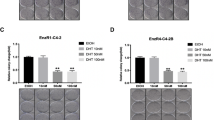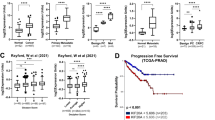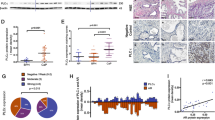Abstract
Castration-resistant prostate cancer (PCa) is refractory to hormone therapy and new strategies for treatment are urgently needed. We found that androgen-insensitive (AI) PCa cells, LNCaP-AI, are reprogrammed to upregulate the mitotic kinase Plk1 (Polo-like kinase 1) and other M-phase cell-cycle proteins, which may underlie AI PCa growth. In androgen-depleted media, LNCaP-AI cells showed exquisite sensitivity to growth inhibition by subnanomolar concentrations of a small molecule inhibitor of Plk1, BI2536, suggesting that these cells are dependent on Plk1 for growth. In contrast, the androgen-responsive parental LNCaP cells showed negligible responses to BI2536 treatment under the same condition. BI2536 treatment of LNCaP-AI cells resulted in an increase in cell death marker PARP-1 (polymerase-1) but did not activate caspase-3, an apoptosis marker, suggesting that the observed cell death was caspase-independent. BI2536-treated LNCaP-AI cells formed multinucleated giant cells that contain clusters of nuclear vesicles indicative of mitotic catastrophe. Live-cell time-lapse imaging revealed that BI2536-treated giant LNCaP-AI cells underwent necroptosis, as evidenced by ‘explosive’ cell death and partial reversal of cell death by a necroptosis inhibitor. Our studies suggest that LNCaP-AI cells underwent reprogramming in both their cell growth and cell death pathways, rendering them highly sensitive to Plk1 inhibition that induces necroptosis. Harnessing necroptosis through Plk1 inhibition may be explored for therapeutic intervention of castration-resistant PCa.
This is a preview of subscription content, access via your institution
Access options
Subscribe to this journal
Receive 50 print issues and online access
$259.00 per year
only $5.18 per issue
Buy this article
- Purchase on Springer Link
- Instant access to full article PDF
Prices may be subject to local taxes which are calculated during checkout









Similar content being viewed by others
References
Jemal A, Siegel R, Ward E, Murray T, Xu J, Thun MJ . Cancer statistics, 2007. CA Cancer J Clin 2007; 57: 43–66.
Wang Q, Li W, Zhang Y, Yuan X, Xu K, Yu J et al. Androgen receptor regulates a distinct transcription program in androgen-independent prostate cancer. Cell 2009; 138: 245–256.
Barr FA, Sillje HH, Nigg EA . Polo-like kinases and the orchestration of cell division. Nat Rev Mol Cell Biol 2004; 5: 429–440.
Takaki T, Trenz K, Costanzo V, Petronczki M . Polo-like kinase 1 reaches beyond mitosis—cytokinesis, DNA damage response, and development. Curr Op Cell Biol 2008; 20: 650–660.
Wang LG, Ossowski L, Ferrari AC . Androgen receptor level controlled by a suppressor complex lost in an androgen-independent prostate cancer cell line. Oncogene 2004; 23: 5175–5184.
Horoszewicz JS, Leong SS, Kawinski E, Karr JP, Rosenthal H, Chu TM et al. LNCaP model of human prostatic carcinoma. Cancer Res 1983; 43: 1809–1818.
Lenart P, Petronczki M, Steegmaier M, Di Fiore B, Lipp JJ, Hoffmann M et al. The small-molecule inhibitor BI 2536 reveals novel insights into mitotic roles of Polo-like kinase 1. Curr Biol 2007; 17: 1–12.
Musacchio A, Salmon ED . The spindle assembly checkpoint in time and space. Nat Rev Mol Cell Biol 2007; 8: 379–393.
Macy B, Wang M, Yu H-G . The many faces of shugoshin, the ‘guardian spirit’, in chromosome segregation. Cell Cycle 2009; 8: 35–37.
Nishino M, Kurasawa Y, Evans R, Lin S-H, Brinkley BR, Yu-Lee L-y . NudC is required for Plk1 targeting to the kinetochore and chromosome congression. Curr Biol 2006; 16: 1414–1421.
Kurasawa Y, Yu-Lee L-y . PICH and cotargeted Plk1 coordinately maintain prometaphase chromosome arm architecture. Mol Biol Cell 2010; 21: 1188–1199.
Lee KS, Yuan YLO, Kuriyama R, Erikson RL . Plk is an M-phase-specific protein kinase and interacts with a kinesin-like protein, CHO1/MKLP-1. Mol Cell Biol 1995; 15: 7143–7151.
Jang Y-J, Ma S, Terada Y, Erikson RL . Phosphorylation of threonine 210 and the role of serine 137 in the regulation of mammalian polo-like kinase. Proc Natl Acad Sci 2002; 277: 44115–44120.
Culig Z, Hoffmann J, Erdel M, Eder IE, Hobisch A, Hittmair A et al. Switch from antagonist to agonist of the androgen receptor bicalutamide is associated with prostate tumor progression in a new model system. Br J Cancer 1999; 81: 242–251.
Thalmann GN, Anezinis PE, Chang SM, Zhau HE, Kim EE, Hopwood VL et al. Androgen-independent cancer progression and bone metastasis in the LNCaP model of human prostate cancer. Cancer Res 1994; 54: 2577–2581.
Sramkoski RM, Pretlow TG, Giaconia JM, Pretlow TP, Schwartz S, Sy M-S et al. A new human prostate carcinoma cell line 22Rv1. In Vitro Cell Dev Biol 1999; 35: 403–409.
Mizushima N, Komatsu M . Autophagy: renovation of cells and tissues. Cell 2011; 147: 728–741.
Caserta TM, Smith AN, Gultice AD, Reedy MA, Brown TL . Q-VD-OPh, a broad spectrum caspase inhibitor with potent antiapoptotic properties. Virology 2003; 191: 589–599.
Vakifahmetoglu H, Zhivotovsky B . Death through a tragedy: mitotic catastrophe. Cell Death Diff 2008; 15: 1153–1162.
Christofferson DE, Yuan J . Necroptosis as an alternative form of programmed cell death. Curr Op Cell Biol 2010; 22: 263–268.
Galluzzi L, Vitale I, Abrams JM, Alnemri ES, Baehrecke EH, Blagosklonny MV et al. Molecular definitions of cell death subroutines: recommendations of the Nomenclature Committee on Cell Death 2012. Cell Death Diff 2012 19: 107–120.
Castedo M, Perfettini J-L, Roumier T, Andreau K, Medema RH, Kroemer G . Cell death by mitotic catastrophe: a molecular definition. Oncogene 2004; 23: 2825–2837.
Degterev A, Huang Z, Boyce M, Li Y, Jagtap P, Mizushima N et al. Chemical inhibitor of nonapoptotic cell death with therapeutic potential for ischemic brain injury. Nat Chem Biol 2005; 1: 112–115.
Liu XS, Song B, Liu X . The substrates of Plk1, beyond the functions in mitosis. Protein Cell 2011; 1: 999–1010.
Strebhardt K . Multifacted polo-like kinases: drug targets and antitargets for cancer therapy. Nat Rev Drug Discovery 2010; 9: 643–660.
Smith MR, Wilson ML, Hamanaka R, Chase D, Kung H, Longo DL et al. Malignant transformation of mammalian cells initiated by constitutive expression of the polo-like kinase. Biochem Biophys Res Comm 1997; 234: 397–405.
Guan R, Tapang P, Leverson JD, Albert D, Giranda VL, Luo Y . Small-interfering RNA-mediated polo-like kinse 1 depletion preferentially reduces the survival of p53-defective, oncogenic transformed cells and inhibits tumor growth in animals. Cancer Res 2005; 65: 2698–2704.
Reagan-Shaw S, Ahmad N . Silencing of polo-like kinase (Plk) 1 via siRNA causes induction of apoptosis and impairment of mitosis machinery in human prostate cancer cells: implications for the treatment of prostate cancer. FASEB J 2005; 19: 611–613.
Schmit TL, Zhong W, Setaluri V, Spiegelman VS, Ahmad N . Targeted depletion of Polo-like kinase (Plk) 1 through lentiviral shRNA or a small molecule inhibitor causes mitotic catastrophe and induction of apoptosis in human melanoma cells. J Invest Dermatol 2009; 129: 2843–2853.
Park JE, Erikson RL, Lee KS . Feed-forward mechanism of converting biochemical cooperativity to mitotic processes at the kinetochore plate. Proc Natl Acad Sci 2011; 108: 8200–8205.
Li J, Wang J, Jiao H, Liao J, Xu X . Cytokinesis and cancer: Polo loves ROCK‘n’ Rho(A). J Genet Genomics 2010; 37: 159–172.
Zhou T, Aumais JP, Liu X, Yu-Lee L-y, Erikson RL . A role for Plk1 phosphorylation of NudC in cytokinesis. Dev Cell 2003; 5: 127–138.
Brennan IM, Peters U, Kapoor TM, Straight AF . Polo-like kinase controls vertebrate spindle elongation and cytokinesis. Proc Natl Acad Sci 2007; 91: 5046–5050.
Bastos RN, Barr FA . Plk1 negatively regulates Cep55 recruitment to the midbody to ensure orderly abscission. J Cell Biol 2010; 191: 751–760.
Artus C, Bouhrad H, Bouharrour A, Brunelle M-N, Hoos S, Yuste VJ et al. AIF promotes chromatinolysis and caspase-independent programmed necrosis by interacing with histone H2AX. EMBO J 2010; 29: 1585–1599.
Degterev A, Hitomi J, Germscheid M, Ch'en IL, Korkina O, Teng X et al. Identification of RIP1 kinase as a specific cellular target of necrostatins. Nat Chem Biol 2008; 4: 313–321.
Hitomi J, Christofferson DE, Ng A, Yao J, Degterev A, Xavier RJ et al. Identification of a molecular signaling network that regulates a cellular necrotic cell death pathway. Cell 2008; 135: 1311–1323.
Vandenabeele P, Galluzzi L, Vanden Berghe T, Kroemer G . Molecular mechanisms of necroptosis: an ordered cellular explosion. Nat Rev Mol Cell Biol 2010; 11: 700–714.
Alano CC, Swanson RA . Players in the PARP-1 cell death pathway: JNK1 joins the cast. Trends Biochem Sci 2006; 31: 309–311.
Hanahan DJ, Weinberg RA . Hallmarks of cancer: the next generation. Cell 2011; 144: 646–674.
Speirs CK, Hwang M, Kim S, Li W, Chang S, Varki V et al. Harnessing the cell death pathway for targeted cancer treatment. Am J Cancer Res 2011; 1: 43–61.
Acknowledgements
We thank Dr Anna Ferrari of New York University for the LNCaP-AI cells and Ms Shenyan Zeng for FACS analysis. This work was supported by NIH training Grants T32-AI07495 and T32-DK07696 for AD and Grants from the NIH (HL080205 to NTE; CA111479 to S-HL; DK53176, AI071130 to L-yY-L), DOD (PC080847, PC093132 to S-HL), Dan L Duncan Cancer Center (L-yY-L and S-HL) and Alkek Award in Experimental Therapeutics (L-yY-L and S-HL).
Author information
Authors and Affiliations
Corresponding author
Ethics declarations
Competing interests
The authors declare no conflict of interest.
Additional information
Supplementary Information accompanies the paper on the Oncogene website
Supplementary information
Rights and permissions
About this article
Cite this article
Deeraksa, A., Pan, J., Sha, Y. et al. Plk1 is upregulated in androgen-insensitive prostate cancer cells and its inhibition leads to necroptosis. Oncogene 32, 2973–2983 (2013). https://doi.org/10.1038/onc.2012.309
Received:
Revised:
Accepted:
Published:
Issue Date:
DOI: https://doi.org/10.1038/onc.2012.309
Keywords
This article is cited by
-
Necroptosis-associated classification combined with tumor microenvironment characteristic analysis of cutaneous melanoma
Scientific Reports (2022)
-
Predicting the prognosis of hepatocellular carcinoma based on the interaction between pyroptosis, apoptosis, and necroptosis
Clinical and Experimental Medicine (2022)
-
Pan-cancer analysis of necroptosis-related gene signature for the identification of prognosis and immune significance
Discover Oncology (2022)
-
The role of necroptosis in cancer biology and therapy
Molecular Cancer (2019)
-
Antitumor activity of the polo-like kinase inhibitor, TAK-960, against preclinical models of colorectal cancer
BMC Cancer (2018)



